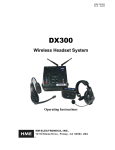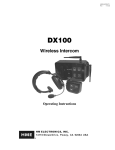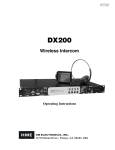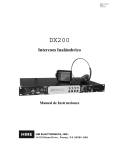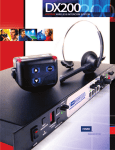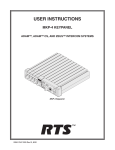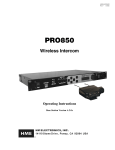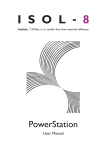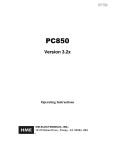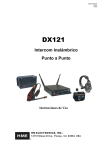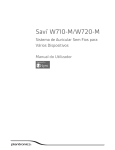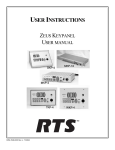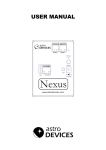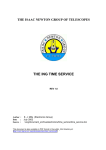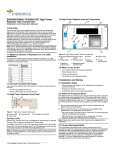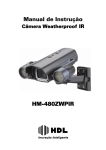Download DX300 Operating Manual
Transcript
HME# 400G605 Rev A 1/18/08 DX300 Wireless Headset System Operating Instructions Table of Contents SECTION 1. SECTION 2. INTRODUCTION..............................................................................................1 EQUIPMENT IDENTIFICATION..................................................................2 STANDARD EQUIPMENT..................................................................................................................................... 2 OPTIONAL EQUIPMENT ...................................................................................................................................... 3 EQUIPMENT FEATURES ...................................................................................................................................... 4 Base Station ......................................................................................................................................................... 4 Beltpac ................................................................................................................................................................. 6 All-In-One Headset (optional) ............................................................................................................................. 6 SECTION 3. EQUIPMENT SETUP ......................................................................................7 BATTERY CHARGER............................................................................................................................................ 7 BASE STATION...................................................................................................................................................... 8 Optional Battery Operation of Base Station......................................................................................................... 9 Multiple Base Stations ....................................................................................................................................... 10 Audio Connection ......................................................................................................................................... 10 Single/Dual Channel Setting ......................................................................................................................... 10 Initialize Multiple Base Stations ................................................................................................................... 11 Base Station Microphone Gain Adjustment....................................................................................................... 12 BELTPACS ............................................................................................................................................................ 13 Beltpac Registration........................................................................................................................................... 13 Beltpac or All-In-One Headset Operating Mode Setup ..................................................................................... 14 Beltpac or All-In-One Headset Adjustments ..................................................................................................... 15 Side Tone Adjustment................................................................................................................................... 15 Microphone Gain Adjustment....................................................................................................................... 15 OPTIONAL REMOTE ANTENNA INSTALLATION......................................................................................... 16 OPTIONAL AUXILIARY EQUIPMENT CONNECTION .................................................................................... 17 SECTION 4. EQUIPMENT OPERATION.........................................................................18 THE BASICS ......................................................................................................................................................... 18 IN THE PRESS BOX – Base Station Operation............................................................................................. 18 ON THE FIELD – Beltpac / All-In-One Headset Operation .......................................................................... 19 Changing Batteries............................................................................................................................................. 20 SECTION 5. TROUBLESHOOTING ..................................................................................21 FREQUENTLY ASKED QUESTIONS................................................................................................................. 23 SECTION 6. TECHNICAL DATA ......................................................................................24 EQUIPMENT SPECIFICATIONS......................................................................................................................... 24 Base Station................................................................................................................................................... 24 Beltpac .......................................................................................................................................................... 25 All-In-One Headset ....................................................................................................................................... 25 BLOCK DIAGRAM............................................................................................................................................... 26 SECTION 7. INDEX...............................................................................................................27 HM Electronics, Inc. is not responsible for equipment malfunctions due to erroneous translation of its publications from their original English version. Illustrations in this publication are approximate representations of the actual equipment, and may not be exactly as the equipment appears. © 2008 HM Electronics, Inc. The HME logo and product names are registered trademarks of HM Electronics, Inc. All rights reserved. FCC NOTICE This device complies with Part 15 of the FCC rules. Operation is subject to the following two conditions: (1) This device may not cause harmful interference, and (2) This device must accept any interference received, including interference that may cause undesired operation. NOTE: This equipment has been tested and found to comply with the limits for a Class A digital device, pursuant to Part 15 of the FCC rules. These limits are designed to provide reasonable protection against harmful interference when the equipment is operated in a commercial environment. This equipment generates, uses and can radiate radio frequency energy and, if not installed and used in accordance with the instruction manual, may cause harmful interference to radio communication. Operation of this equipment in a residential area is likely to cause harmful interference, in which case the user will be required to correct the interference at his own expense. Changes or modifications not expressly approved by HM Electronics, Inc. could void the users authority to operate this equipment. Hereby, HM Electronics, Inc. declares that the DX300 is in compliance with the essential requirements and other relevant provisions of R&TTE Directive 1999/5/EC. This product operates in the 2400 to 2483.5 MHz frequency range. The use of this frequency range is not yet harmonized between all countries. Some countries may restrict the use of a portion of this band or impose other restriction relating to power level or use. You should contact your Spectrum authority to determine possible restrictions. WASTE ELECTRICAL AND ELECTRONIC EQUIPMENT (WEEE) The European Union (EU) WEEE Directive (2002/96/EC) places an obligation on producers (manufacturers, distributors and/or retailers) to take-back electronic products at the end of their useful life. The WEEE Directive covers most HME products being sold into the EU as of August 13, 2005. Manufacturers, distributors and retailers are obliged to finance the costs of recovery from municipal collection points, reuse, and recycling of specified percentages per the WEEE requirements. Instructions for Disposal of WEEE by Users in the European Union The symbol shown below is on the product or on its packaging which indicates that this product was put on the market after August 13, 2005 and must not be disposed of with other waste. Instead, it is the user’s responsibility to dispose of the user’s waste equipment by handing it over to a designated collection point for the recycling of WEEE. The separate collection and recycling of waste equipment at the time of disposal will help to conserve natural resources and ensure that it is recycled in a manner that protects human health and the environment. For more information about where you can drop off your waste equipment for recycling, please contact your local authority, your household waste disposal service or the seller from whom you purchased the product. LIMITED WARRANTY HM Electronics, Inc. (“HME”) warrants the DX300 for a period of two (2) years* from the date of purchase against defects in materials or workmanship provided it was purchased from an authorized dealer. During the warranty period, defective HME Products will be repaired without charge for parts and labor. Simply return the defective HME Product with your sales slip as proof of the date of purchase. If a defective HME Product is returned prepaid to HME or an authorized HME service center, it will be repaired and returned prepaid. Replacement of nonconforming goods and repair of defective HME Products are the sole and exclusive remedies available under this warranty. This warranty shall be void if (a) the HME Products have been tampered with, neglected, modified, abused or misused; (b) anyone other than HME employees or authorized HME service representatives provide service on or to the HME Products; or (c) the serial numbers are not intact. THIS WARRANTY COVERS HME PRODUCTS, AND IS NOT EXTENDED TO ASSOCIATED NON-HME PRODUCTS OR ACCESSORIES, OR ANY DAMAGE TO HME PRODUCTS CAUSED BY SUCH NON-HME PRODUCTS OR ACCESSORIES. IN NO EVENT WILL HME BE LIABLE FOR INCIDENTAL OR CONSEQUENTIAL DAMAGES, OR LOSS OF PROFITS ARISING FROM THE USE OF OR INABILITY TO USE ANY HME PRODUCTS, OR FROM ACCIDENTS OR ACTS OF GOD. HME MAKES NO WARRANTIES, EXPRESS OR IMPLIED, INCLUDING WARRANTIES OF MERCHANTABILITY AND FITNESS FOR A PARTICULAR PURPOSE, WITH RESPECT TO HME PRODUCTS EXCEPT AS SPECIFICALLY SET FORTH ABOVE. This warranty is provided to the original purchaser of the HME Products described on this packing list and is non-transferable without the written permission of HME. RETURN POLICY: ALL SALES FINAL. No returns will be accepted (except for nonconforming goods as specified above) unless HME authorizes such return and unless such return occurs within 90 days of receipt. A 15% restocking charge will be assessed on all such authorized returns. Authorized returns must be freight prepaid and shall include an authorization number noted on the outside of the package. Such authorization number will be provided by HME at the time it authorizes such return. All freight sent collect and packages without an authorization number will be refused and returned to sender. * Exceptions: Certain exceptions may apply. Refer to the HME website at http://www.hme.com/proAudio.cfm. SECTION 1. INTRODUCTION The DX300 provides secure communication among the coaching staff Spotters in the press box can communicate with offense “O” only, defense “X” only or “ALL” coaches via headsets connected directly to the base station Coaches on the sideline wear beltpacs with headsets to communicate with each other and the spotters Beltpacs can be set up for communication with any combination of offense, defense and ALL This manual includes detailed setup and operating instructions for your DX300 system Basic 5-Coach System 1 base station 3 beltpacs 5 headsets Expanded 10-Coach System 2 base stations 6 beltpacs 10 headsets 1 SECTION 2. EQUIPMENT IDENTIFICATION STANDARD EQUIPMENT Antennas Base station interconnect cable Headset Power adapter and cord Base station 10-pin spring clamp connector Battery sled OR Beltpac with headset, pouch and battery All-in-one headset with battery Battery charger with power supply and cord for beltpac and all-in-one headset batteries Travel case 2 OPTIONAL EQUIPMENT Headset with dual ear muffs Model # HS14D Headset, all-in-one, with battery Model # WH300 Headset extension cable, 6 ft (1.83 meter) Foam earmuffs for all-in-one headset Rechargeable battery for base station Model # BAT850 Battery charger for base station batteries Model # AC850 Remote antenna kit with 6 foot (1.83 meter) cable and bracket Remote antenna kit with 30 foot (9.14 meter) cable and bracket Adapter cable for headset w/ dynamic microphone and XLR connector Model # MD-XLR4F MD-XLR4M MD-XLR5F 3 EQUIPMENT FEATURES Base Station Top Panel — Antennas Battery compartment latches Power button Left headset volume control Right headset volume control Left talk lights Right talk lights Left select button Right select button Left talk button Right talk button Active Communicator lights Clear registration button Registration Registration button status indicator 4 Reset switch (recessed) Front Panel — Auxiliary audio in/out volume adjustments (recessed) Left Side Panel — Cable “input” from another base station Left headset connector Microphone gain adjustment for left headset Single/Dual base station selection switch Right Side Panel — Right headset connector Microphone gain adjustment for right headset Primary/Secondary base station selection switch Cable “output” to another base station Power supply connector Rear Panel — Auxiliary audio input/output connector Antenna connectors 5 Beltpac Defense button All button Offense button Battery Power/Offense talk light Battery release latch Power/Defense talk light Power button Headset cable connector Volume up button Volume down button All-In-One Headset (optional) Offense button Defense button Power/Talk light Volume up button Power button Headband slide-to-fit Microphone boom All button Volume down button Battery release latch Sanitary muff Talk light Battery 6 SECTION 3. EQUIPMENT SETUP BATTERY CHARGER NOTE: 1 Set up the battery charger and charge all beltpac batteries while you are setting up the base station Connect power supply to charger and electrical outlet Power supply 2 Power supply cord Charge all beltpac batteries Charging time is approximately 3 hours Put up to 4 batteries in charging ports Storage ports for charged batteries Status lights next to each charging port Red light Stays on steady while battery is charging Green light Goes on when battery is fully charged Yellow light Stays on steady when charging port is empty Flashes if battery is too hot to charge Next to battery in charging port means charge has failed – See instructions on side of charger 7 BASE STATION 1 Screw both antennas onto the connectors on the back of the base station Tighten at 90° angle 2 Plug power adapter into base station and screw nut onto connector, then plug power cord into power adapter and electrical outlet NOTE: 3 4 5 A fully charged battery can be kept in the base station as a backup in case of AC power interruption Set up base station in press box, where no objects are blocking the line-of-sight from base station to your sideline If interference is caused by objects in line-of-sight or sun screen on press box windows, refer to remote antenna installation on page 16 Press POWER button to turn power on Plug headsets into base station, inserting headset plugs all the way into connectors Left headset connector 8 Right headset connector Optional Battery Operation of Base Station The base station can operate on battery power when AC power is unavailable NOTE: Always plug base station into AC power when it is available Turn base station off during halftime to conserve battery power Typical base station battery life when used continuously is as follows Energizer Lithium BAT850 Rechargeable Battery Duracell Coppertop 1 2 6 hours 3 hours 1 hour If you are using the battery sled, load 6 “AA” batteries into it Pull back on the battery compartment latches and lift the battery compartment cover on the base station Battery compartment latches Battery sled BAT850 Battery Battery compartment cover 3 4 Insert the battery sled or rechargeable BAT850 battery (optional) into the battery compartment and close the cover If you are using the BAT850 battery, put it in the AC850 battery charger (optional) for recharging after each use Follow the instructions received with the charger Charging time is approximately 3 hours AC850 Battery Charger NOTE: When base station battery power is low, everyone connected to or registered to that base station will hear a tone in their headset, repeating every 8 seconds and both headset select lights will blink 9 Multiple Base Stations Up to 20 coaches can communicate using the DX300, 5 per base station, by interconnecting up to 4 base stations as described below Audio Connection Connect base stations with the provided interconnect cable, from the BASE OUT connector on one to the BASE IN connector on the other BASE OUT connector BASE IN connector Interconnect cable Secondary base station Primary base station Single/Dual Channel Setting Single channel (SNGL) ― 4 beltpacs and/or all-in-one headsets can be used in the hands-free mode Dual channel (DUAL) ― 3 beltpacs and/or all-in-one headsets can be used in the hands-free mode On the right side of the base stations, set the MODE switch to the SNGL or DUAL position MODE switch Right side of base station 10 Initialize Multiple Base Stations Multiple base stations must be “initialized” according to the following instructions, so their frequencies will not cause self-interference After initializing each base station, register each beltpac that will be used with that base station BASE switch 1 On the right side of the secondary base station, place the BASE switch in the SEC position Right side of base station 2 With the primary base station powered on first, turn on the secondary base station Registration status window with double bar The REGISTRATION STATUS window will show a double bar 3 4 Press the REGISTER button on the primary base station The REGISTRATION STATUS window will show a small “o” Press the REGISTER button on the secondary base station to assign it a number (1, 2 or 3) Wait until the base is initialized (approximately 10 seconds) RECOMMENDED: If only two base stations will be used, set the secondary base station to #2 5 6 7 When initialization is complete, the REGISTRATION STATUS window will show one bar Press the REGISTER button on the primary base station to clear the REGISTRATION STATUS window The display will also go blank after timing out Repeat steps 1 – 6 to initialize up to three secondary base stations NOTE: If you have more than one base station, you must register each beltpac to the base station it will be used with 11 Base Station Microphone Gain Adjustment The microphone gain adjustment allows you to adjust the level of your voice as it is transmitted from the headsets plugged into the base station 1 Insert small screwdriver On the right side of a base station, locate the recessed MIC GAIN adjustment Base station microphone gain adjustment 2 3 Insert a small screwdriver in the hole and turn the adjustment clockwise to increase or counterclockwise to decrease microphone gain Speak into the right headset microphone and listen to your own voice level (sidetone) in the headset as you adjust the microphone gain 4 Repeat steps 1 through 3 for left side headset 5 Repeat steps 1 through 4 for each base station NOTE: Base station microphone gain is factory set at about one-third from minimum level 12 BELTPACS Beltpac Registration NOTE: 1 2 3 Registration of all-in-one headsets is the same as the beltpac registration described below, except for step 2 If you have more than one base station, you must register each beltpac to the base station it will be used with Turn the base station power on, and beltpac power off Plug the headset into the beltpac and put the headset on your head Press the REGISTER button on the base station registration panel A lower case “o” will appear on the REGISTRATION STATUS window 4 REGISTER button Press and hold the ALL button on the beltpac while you press and release its PWR (power) button REGISTRATION STATUS window ALL button After a brief delay, you should hear “Registration complete” in the headset An ID number for this beltpac will appear briefly on the REGISTRATION STATUS window 5 Repeat steps 1 through 4 for each beltpac NOTE: If the registration is not successful, you will hear “Registration failed.” If this happens, refer to Section 5. TROUBLESHOOTING, on page 21 NOTE: If you try to register more than 15 beltpacs to a base station: Power button An “F” (Full) will appear in the REGISTRATION STATUS window and you will hear “Registration failed” in the headset Clear all current registrations by pressing and holding the CLEAR REGISTRATION button while you press and release the RESET button with a pen point Continue holding the CLEAR REGISTRATION button after you release the RESET button until the clear code “c” (lower case) appears on the REGISTRATION STATUS window Register all beltpacs, one at a time, including previously registered beltpacs 13 Beltpac or All-In-One Headset Operating Mode Setup Set up beltpacs and/or all-in-one headsets to operate in the desired mode by pressing and holding the button combinations shown below when you press the PWR (power) button to turn the unit on Mode Button Combination Head Coach (default) NOTE: Button Functions Hold X + O + ALL and press PWR X, O & ALL have normal functions Beltpacs and all-in-one headsets are shipped in the Head Coach mode Offense only Hold O and press PWR X & O work as O ALL has no function Offense + ALL Hold O + ALL and press PWR X & O work as O ALL has normal function Defense only Hold X and press PWR X & O work as X ALL has no function Defense + ALL Hold X + ALL and press PWR X & O work as X ALL has normal function Offense + Defense only Hold X + O and press PWR X & O have normal functions ALL has no function Latching Hold ALL + ▲ and press PWR (Hands-Free, Full-Duplex) X, O & ALL will latch on when pressed and released, for a normal two-way conversation Push-To-Talk (PTT) X, O & ALL must be pressed and held while you talk, and released to listen Hold ALL + ▼ and press PWR NOTE: Mode settings will be stored, so your beltpacs and/or all-in-one headsets will have the same mode settings after you turn them off and back on NOTE: ALL does not latch on, and must be held down to hear both O and X 14 Beltpac or All-In-One Headset Adjustments Side Tone Adjustment When you speak into the microphone, you can hear side tone (your own voice) in the headset Side tone can be adjusted as follows: 1 2 Be sure the beltpac or all-in-one headset power is on While holding down the “O” button, press the volume-up ▲ or volumedown ▼ button as many times as needed to reach an acceptable level You do not hear beeps except for maximum or minimum double beep Maximum side tone level is recommended Microphone Gain Adjustment Some users speak louder or softer than average The microphone gain adjustment helps to compensate for extremes in speaking level of coaches using beltpacs or all-in-one headsets NOTE: 1 2 The microphone gain can be monitored through sidetone, or preferably by someone else using a beltpac or all-in-one headset, or at the base station Be sure the beltpac or all-in-one headset power is on While holding down the “X” button, press the volume-up ▲ or volumedown ▼ button as many times as needed to reach an acceptable level You do not hear beeps except for maximum or minimum double beep Recommended microphone gain levels are: Beltpacs – 10 clicks down from maximum All-in-one headsets – 12 clicks down from maximum NOTE: You will hear “Maximum” if you attempt to go higher than maximum microphone gain You will hear repeating beeps if you attempt to go lower than minimum microphone gain Microphone gain and side tone adjustments will be saved in memory and does not need to be reset after the unit is turned off and on 15 OPTIONAL REMOTE ANTENNA INSTALLATION It may be necessary to locate the antennas away from the base station if it is not possible to avoid obstructions between it and the sideline, or if the press box has windows that are coated with a metalized sun reflecting film Either of these situations may block signals from the press box base station to the beltpacs on the field Remote antenna kits with either 6 foot (1.83 meter) or 30 foot (9.14 meter) cables can be used to mount the antennas wherever necessary to alleviate this problem To order a remote antenna kit, refer to the optional equipment shown on page 3. Installation instructions are enclosed with the remote antenna kit 16 OPTIONAL AUXILIARY EQUIPMENT CONNECTION Auxiliary equipment such as audio/video recorder or a hardwired intercom can be connected to the rear panel of the base station 1 Connect the wires from your auxiliary audio equipment to the enclosed 10-pin connector according to the following table 10-pin spring clamp connector 2 3 Pin Connections 1 2 3 4 5 6 7 8 9 10 Aux In − O Aux In + O Aux Out − O Aux Out + O Ground No Connection Aux In − X Aux In + X Aux Out − X Aux Out + X Differential pair Differential pair Differential pair Differential pair Plug the connector into the back panel of the base station as shown above Using a small screwdriver in the holes on the front panel of the base station, you can adjust the IN and OUT sound level of “O” and “X” communication channels as needed 17 SECTION 4. EQUIPMENT OPERATION THE BASICS IN THE PRESS BOX – Base Station Operation Headset volume Channel indicator lights (Offense, All or Defense) Green Listen only Red Talk and listen Left headset controls Right headset controls Channel select button (Offense, All or Defense) Talk button (Push ON – Push OFF) 1 2 3 Press base station POWER button to turn on power Put left or right headset on your head Use headset controls on same side of base station as headset Adjust headset volume as needed CAUTION: 4 5 6 Having your headset at a high volume level for a long time can cause hearing damage Press channel SELECT button; Green light appears above O, ALL or X selection ― Press SELECT button again to change selection To talk to coaches, press and release TALK button − Green light turns red Talk and listen to coaches as in normal telephone conversation Press and release TALK button again when you finish talking (You will still hear the other coaches but they will not hear you) To turn base station off, press and hold POWER button until the lights go off 18 ON THE FIELD – Beltpac / All-In-One Headset Operation 1 2 3 Be sure fully charged battery is in the unit If using beltpac — Plug headset into beltpac and put headset on your head Slide beltpac into pouch and clip it on your belt Press and release PWR (power) button to turn unit on Beltpac power button 4 All-in-one headset power button (above earpiece on inside surface) Press and release O button to communicate with offense coaches or X button to communicate with defense coaches Speak to offensive coaches Speak to defensive coaches 5 To communicate with both offense and defense coaches, press and hold ALL button while talking Speak to all coaches 6 Adjust headset volume as needed Decrease volume Increase volume CAUTION: 7 Having your headset at a high volume level for a long time can cause hearing damage To turn unit off, press and hold power button for about 2 seconds until you hear “Power off” 19 Changing Batteries Beltpac batteries typically provide 20 hours of continuous use in listen mode If you hear “Change battery” in your headset ― 1 2 3 4 5 6 If using beltpac, remove it from its pouch Slide battery release latch in direction of arrow Lift battery out of beltpac or headset Place battery in battery charger port for recharging Install fully charged battery in beltpac or headset If using beltpac, put it back in its pouch Battery release latch Battery Battery release latch Battery Beltpac All-in-one headset 20 SECTION 5. TROUBLESHOOTING If you are unable to correct any of the problems described below or if your problem is not covered, call 1-800-909-6604 for assistance Power light on base station does not come on when power button is pressed Be sure the power supply is properly connected to the base station, and the power cord is properly connected to the power supply and electrical outlet If operating on battery power, be sure the battery is charged and in the battery compartment with the cover is securely closed Beltpac/Headset power lights do not turn green and you hear “out of range” Be sure the base station power is on Turn beltpac/headset power on and off Beltpac/Headset may be too far from the base station When trying to register a beltpac/headset, you hear “registration failed” Press the RESET button on the base station with the point of a pen The REGISTRATION STATUS window will show “8” and then become blank Try again to register the beltpac/headset If registration fails again, call your dealer for assistance. Other coaches can not hear me when I talk Be sure you are pressing the X or O button on the beltpac/headset, or the TALK button on the base station Be sure you are pressing the button for the correct channel Be sure the headset plug is properly connected to the beltpac or base station With more than one base station, offensive spotter can not hear O or ALL transmission from another base, or defensive spotter can not hear X or ALL transmission from another base Be sure interface cable is properly connected from BASE OUT on the primary base station to BASE IN on the secondary base station, and so on If problem is not resolved, try using a different interface cable No or low auxiliary audio sound Check wiring from auxiliary equipment to AUX AUDIO connector on back of the base station Turn AUX AUDIO adjustments on front of base station with a small standard (flat) screw driver, clockwise to increase level and counterclockwise to decrease level 21 Coaches using beltpacs or all-in-one headsets can not hear or talk to coaches using base station headsets Be sure base station headsets are fully plugged into the base station headset connectors Be sure the appropriate SELECT lights are red (O, X or ALL) when coaches at base station are talking Be sure coaches are talking or listening on the right channel (O, X or ALL) Beltpac range is bad Be sure antennas are properly connected and tightened on base station Be sure base station is positioned where there are no physical obstructions blocking line-ofsight from the base station to your sideline Beeping is heard in base station headset and SELECT lights are blinking Base station is operating on battery power and battery is low Not all beltpac buttons are working Buttons may have been “locked out” in beltpac setup (See page 14) There is interference from a cordless telephone If there is a 2400MHz cordless telephone nearby, interference may occur If it does occur, changing frequencies on the telephone should eliminate the problem If it does not, move the phone as far as possible from the base station, or use another type phone (If your base station does not have a battery backup) In the event of an electrical power outage — such as from lightning or a power generator failure, if you experience problems with your DX300 equipment after the power comes on again, unplug the AC power supply from its electrical outlet and wait 15 seconds, then plug it back in. 22 FREQUENTLY ASKED QUESTIONS 1. Are the battery charger and base station power supplies interchangeable? Yes 2. What is the maximum recommended number of base stations that can be linked together with interconnect cables? Four 3. Does linking the base stations automatically prevent them from interfering with each other? No, all base that are linked together must be initialized to prevent them from interfering with each other’s frequencies 4. If the primary base station is turned off just momentarily (before the secondary base(s) have a chance to start working independently), will the secondary base(s) automatically reinitialize to the primary? Yes, the secondary base(s) will re-establish communication without being initialized again 5. Will a secondary base station continue to operate if its primary is turned off for a period of time? Yes & No. Secondary base stations will initially stop operating when the primary base is turned off, but will resume operation independently after about 40 seconds. Three bars will appear in its REGISTRATION STATUS display, and its beltpacs will still be able to communicate If the primary base station is turned back on, the secondary base must be turned off and on again to re-establish proper initialization 6. Can I use more than three beltpacs on a single base station in dual channel mode? Yes, but only three users will be able to transmit at the same time Up to 15 beltpacs can be registered to a single base station Beltpacs and all-in-one headsets should be placed in press-to-talk mode when more than 3 beltpacs or all-in-one headsets are used (See page 10) 7. What should I do if my carrying case and equipment get wet? Dry them out thoroughly before further use Be sure all equipment is dry before using it again CAUTION: Plugging wet electrical equipment into an AC power outlet is dangerous! 23 SECTION 6. TECHNICAL DATA EQUIPMENT SPECIFICATIONS Base Station GENERAL ⎯ Frequency Range: Frequency Response: Power Requirements: Temperature Range: Size: Weight: # of Beltpacs per Base: 8-Wire I/O: Auxiliary Audio: Headset Connectors: Electret microphone: Headset Output: Top Panel Controls and Indicators: Front Panel: Left Panel: Right Panel: Rear Panel: Antenna Type: System Distortion: Communication Security: 2400 – 2483.5 MHz 200 Hz to 3.5 kHz 100-240VAC, 50-60Hz 12-14VDC or six AA batteries (NiMH optional) 32-122°F (0-50°C) 8” x 8” x 3.5” (20.32 x 20.32 x 8.89 cm) 2.75 lb with battery (1.25 kg) 15 can be registered; any 4 can have simultaneous full-duplex communication at one time (in single channel mode) RJ45, 600Ω balanced out, high impedance in 10-Ckt Phoenix connector, 600Ω balanced out, high impedance in, level adjustable 4-pin mini-DIN 45 KΩ 200mW into 32Ω Power button Left and Right headset controls Rotary knobs for headset volume (VOL) adjustment Headset SELECT buttons (O=Offense, X=Defense or ALL) Headset TALK buttons Registration controls CLEAR REGISTER button REGISTER button RESET switch (recessed) REGISTRATION STATUS indicator Headset transmit dual-color LEDs, left and right (red/green) – O, X, ALL RECEIVE LEDs (green) – O, X, ALL Auxiliary input and output level adjustments 8-wire audio port Microphone gain adjustment Left headset connector Right headset connector Microphone gain adjustment 8-wire audio port Single/Dual selection switch Primary/Secondary selection switch Auxiliary input and output connectors Antenna connectors External ½ -wave dipole (R-TNC connector) RX/TX horizontal/vertical diversity <2% 64-bit encryption dual-slot diversity 24 TRANSMITTER ⎯ Type: Transmit Power: Modulation Type: Frequency Stability: Harmonics/Spurious: RECEIVER ⎯ Type: RF Sensitivity: Frequency Stability: Distortion: Frequency hopping, spread spectrum 100mW burst Gaussian filtered FSK, TDMA 13 ppm Exceeds FCC and ETSI specifications over temperature Frequency hopping, spread spectrum <–90dBm w 10-3 BER 13 ppm <2% Beltpac Frequency Range: Antenna: Frequency Response: Transmit Power: RF Sensitivity: Battery Requirements: Battery Life: Temperature Range: Weight: Headset Connector: Microphone: Headset Output: Controls: Indicators: 2400 MHz – 2483.5 MHz Internal, horizontal/vertical diversity 200 Hz to 3.5 kHz 100mW burst <–90dBm w 10-3 BER 3.6V lithium ion, rechargeable Hands-free – up to 14 hours PTT – up to 20 hours 32-122°F (0-50°C) 7.4 oz (.21 kg) with battery and pouch 4-pin, mini-DIN Electret 160mW into 32Ω Power PWR, Volume-up S, Volume-down T, O, X, ALL Dual-color LED (red/green) All-In-One Headset Frequency Range: Antenna: Frequency Response: Transmit Power: RF Sensitivity: Battery Requirements: Battery Life: Temperature Range: Weight: Microphone: Headset Output: Controls: Indicators: 2400 MHz – 2483.5 MHz Internal 200 Hz to 3.5 kHz 100mW burst <–90dBm w 10-3 BER 3.6V lithium ion, rechargeable Hands-free – up to 14 hours PTT – up to 20 hours 32-122°F (0-50°C) 5.7 oz (.16 kg) with battery Electret 160mW into 32Ω Power, Volume-up S, Volume-down T, O, X, ALL Transmit LED (red in defense / green in offense) Power LED (red/green) 25 BLOCK DIAGRAM 26 SECTION 7. INDEX Base station audio connection (multiple base stations) ...............................................................................10 features......................................................................................................................................4 initialization (multiple base stations) ........................................................................................11 microphone gain adjustment ...................................................................................................12 operation..................................................................................................................................18 setup (multiple base stations)..................................................................................................10 setup (single base station).........................................................................................................8 setup for battery operation.........................................................................................................9 single/dual channel setting ......................................................................................................10 specifications ...........................................................................................................................24 Battery charger setup....................................................................................................................7 Beltpac changing batteries ...................................................................................................................20 features......................................................................................................................................6 microphone gain adjustment ...................................................................................................15 operating mode setup..............................................................................................................14 operation..................................................................................................................................19 registration...............................................................................................................................13 side tone adjustment ...............................................................................................................15 specifications ...........................................................................................................................25 Block diagram .............................................................................................................................26 Equipment basic 5-coach layout..................................................................................................................1 extended 10-coach layout .........................................................................................................1 optional ......................................................................................................................................3 standard.....................................................................................................................................2 Headset, all-in-one changing batteries ...................................................................................................................20 features......................................................................................................................................6 operating mode setup..............................................................................................................14 operation..................................................................................................................................19 registration...............................................................................................................................13 specifications ...........................................................................................................................25 Optional equipment installation auxiliary equipment connection ...............................................................................................17 remote antennas......................................................................................................................16 Troubleshooting ..........................................................................................................................21 Frequently Asked Questions ...................................................................................................23 27































